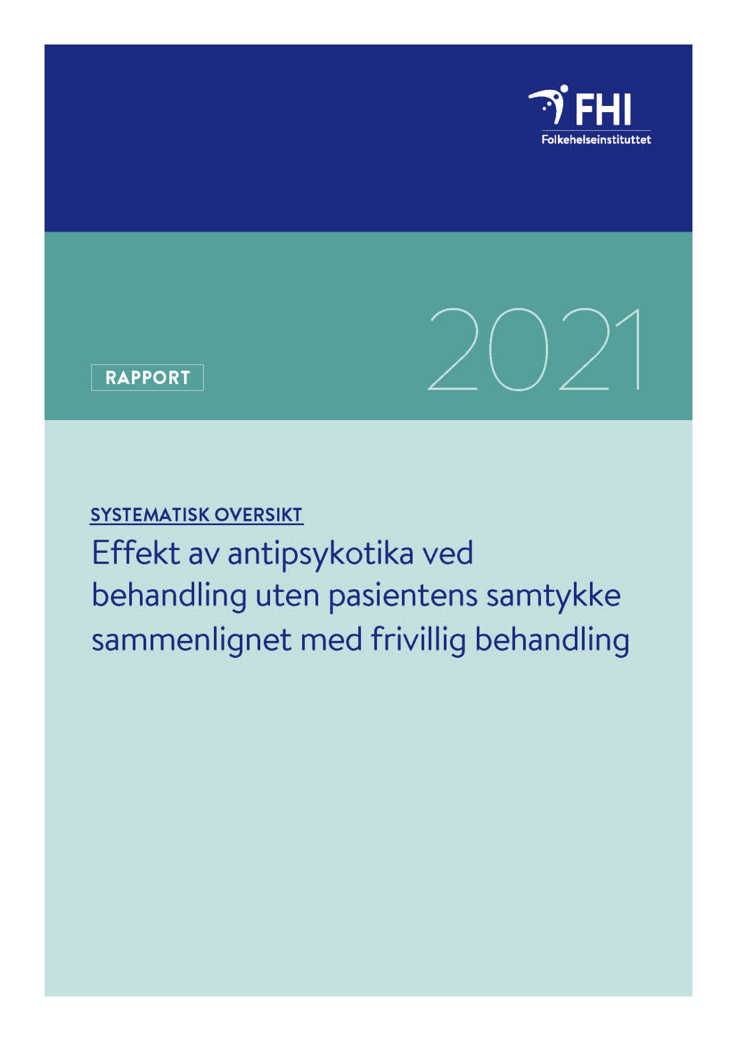The effect of involuntary treatment with antipsychotic medication: a systematic review
Systematic review
|Published
The purpose of this systematic review is to summarize research on the effect of involuntary treatment with antipsychotics compared with voluntary treatment with antipsychotics in peo-ple over 16 years of age diagnosed with psychotic disorders.
Key message
Research based knowledge about the effect of antipsychotics largely comes from studies where patients receive medication voluntarily. In a real-life setting, there are also patients who receive antipsychotics involuntarily.
The purpose of this systematic review is to summarize research on the effect of involuntary treatment with antipsychotics compared with voluntary treatment with antipsychotics in people over 16 years of age diagnosed with psychotic disorders.
To identify relevant literature, we performed two systematic searches in databases, searched for grey literature in Nordic library catalogues and Google, searched the reference lists of all papers read in full-text and contacted experts within relevant fields.
We included two small observational studies, one prospective study from Germany and one retrospective study from USA. Both studies were conducted with inpatients in psychiatric institutions. Both studies were rated as having high risk of bias.
We are uncertain about whether the effect of involuntary treatment with antipsychotics is different from the effect of voluntary treatment with antipsychotics in people with psychotic disorders, on the outcomes; psychosis symptoms, readmission, and psychosocial functioning.
Summary
Background
The evidence base for antipsychotic medication is mainly based on studies where patients receive these drugs voluntarily. In a real-life setting, the use of antipsychotics also occurs in treatment without patient consent, i.e. involuntary treatment. We know little about whether the effect of involuntary treatment with antipsychotics is different compared to the effect of voluntary treatment with antipsychotics.
The purpose of this systematic review is to summarize research on the effect of antipsychotics in treatment without the patient's consent (involuntary treatment) compared with voluntary treatment with antipsychotics, in people over 16 years of age with psychotic disorders.
Method
We conducted this systematic review according to the procedures put forward in the Norwegian Institute of Public Health's handbook for evidence synthesis, and in a peer-reviewed project plan. To identify relevant studies, a librarian searched eight international literature databases, such as MEDLINE, EMBASE and PsycINFO, in December 2020. We also searched for grey literature in Google and Scandinavian library catalogues and reviewed the reference lists of studies reviewed in full text. We did not identify any studies published after 2010 that met our inclusion criteria, however, we identified one study published before 2010 that was relevant when reviewing reference lists. In February 2021, we therefore expanded our literature search and included studies without restrictions on publication year.
We included controlled studies (studies with a comparison group) which examined the effect of involuntary treatment with antipsychotics compared with voluntary treatment with antipsychotics in people over 16 years of age with psychotic disorders. We were interested in the following outcomes: change in psychosis symptoms, side effects (serious adverse events), readmission, quality of life, functioning in social relationships or employment.
Two researchers independently selected relevant studies and then assessed the risk of bias in the included studies using a checklist for cohort studies. Two researchers extracted relevant data and summarized the results in text and tables. Where possible we calculated effect estimates for relevant outcomes reported in the included studies. We assessed our confidence in the results using the GRADE approach.
Results
The two literature searches and the search for grey literature resulted in 7601 references. We included two small observational studies; one American retrospective study published in 1991 with 102 participants and one German prospective study published in 2004 with 88 participants. Both studies were conducted in an inpatient hospital setting and compared involuntary treated patients with voluntary treated patients. The studies measured psychosis symptoms, readmission and functioning, in addition to other outcomes that wasn’t relevant for our aim.
The included studies had a high risk of bias, due to baseline imbalance (e.g. severity of the disorder and general resistance against treatment). The studies did also fail to consider possible known confounding factors in their analyses. One study had a retrospective design and did not mention which criteria was used to measure the outcomes. The other study had very few participants that received antipsychotics, imbalance in the number of participants in the groups and had no blinding of outcome assessments.
We have too low confidence in the effect estimates to conclude whether the effects of antipsychotics are different in involuntary treatment compared with voluntary treatment (Table 2).
Table 2: Reported effects and certainty of findings of the included studies | |||||
Outcomes | № of participants | Certainty of the evidence | Relative effect | Anticipated absolute effects | |
Risk with voluntary treatment | Risk difference with involuntary treatment | ||||
Thought disorders | 11 | ⨁◯◯◯ | RR 1.75 | 286 per 1 000 | 214 more per 1 000 |
Hallucination | 19 | ⨁◯◯◯ | RR 1.38 | 455 per 1 000 | 173 more per 1 000 |
Delusions | 46 | ⨁◯◯◯ | RR 2.52 | 238 per 1 000 | 362 more per 1 000 |
Readmission | 102 | ⨁◯◯◯ | RR 0.88 | 157 per 1 000 | 19 fewer per 1 000 |
Psychoses symptoms | 88 (1 study) | ⨁◯◯◯ | Researchers did not provide data, but reported no difference between the groups. | ||
Psychosocial Functioning | 88 (1 study) | ⨁◯◯◯ | Researchers did not provide data, but reported no difference between the groups. | ||
CI: Confidence interval; RR: Risk ratio; PANSS: Positive and Negative Syndrome Scale; GAF: Global Assessment of Functioning
Explanations:
a. High risk of bias in the included studies
- Imprecision (few participants)
c. Indirectness (conducted in a country with starkly different legal setting for compulsory treatment than Norway, and generalizability is unclear)
d. Indirectness (intervention group was subject to further forms of compulsory actions, and it was not possible to assess how many participants were effected or how results were impacted)
Discussion
Based on our exhaustive literature search we can be certain that there is very little research investigating the effect of involuntary treatment with antipsychotics compared with voluntary treatment with antipsychotics. The studies that do exist are older and with a high using register risk of bias due to incomplete reporting and lack of adjustment for key confounding factors. A significant research effort is therefore needed to be able to answer our research question. Ideally, such research efforts should consist of larger, well-designed randomized studies. This is not possible as there are major ethical, methodological and clinical challenges that are incompatible with investigations of this research question involving this population group.
An alternative research approach that will enable to answer this type of research question could be using registry data. Most patients will be exposed to different treatment regime during the disease and many will be exposed to both compulsory and voluntary treatment. One way of using register data are by matching people according to important clinical variables, such that the only difference between them is exposure to compulsory treatment. In this way patient are compared both with themselves and with others.
Conclusion
It is uncertain whether the effect of involuntary treatment with antipsychotics is different compared with the effect of voluntary treatment with antipsychotics in terms of the outcomes psychosis symptoms, readmission, and psychosocial functioning.


